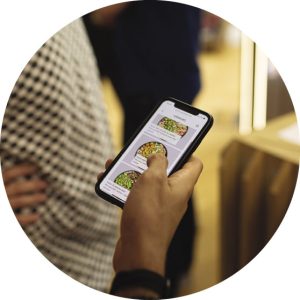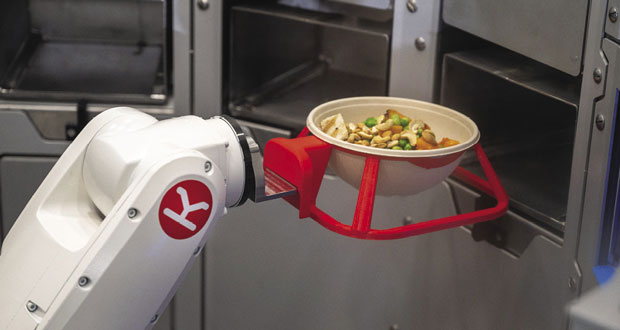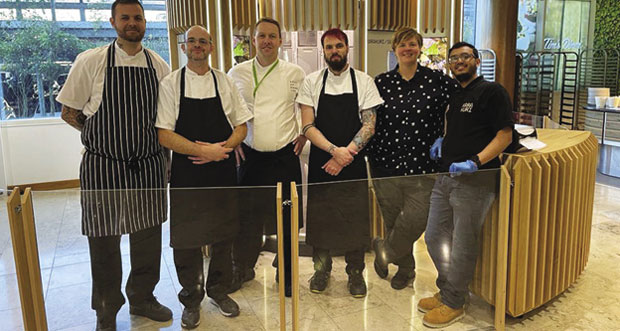DATA GATHERING
One of the most innovative features of the robot is the use of AI to enable prediction-based service, with the end goal being that when there are hundreds of these machines installed in different sites you can aggregate the data and map it against things like weather forecasts, traffic analysis, the day of the month/week, where it is in the year, and in doing so understand the food demand patterns.
Explains Wragg: “In this way you can forecast out what you’re likely to need to make in the kitchen and order the ingredients in advance that support that, based on large volumes of data that you are intelligently filtering in order to plan forward.”
 For customers the ordering process is via similar QR based app system we’ve all got used to in pubs and restaurants during the pandemic. Throughout the Ocado offices there are QR codes for staff to pre-order for ‘click and collect’ – enabling them to order their meal and nominate the time they want to collect it.
For customers the ordering process is via similar QR based app system we’ve all got used to in pubs and restaurants during the pandemic. Throughout the Ocado offices there are QR codes for staff to pre-order for ‘click and collect’ – enabling them to order their meal and nominate the time they want to collect it.
Says Wragg: “What that means is by around 11 to 11.30 each day we pretty much know the exact quantity of everything we’re going to sell that day, so if we know we’ve got a quiet day we can pass that back to the catering team. We also get feedback from customers in real-time on every order that comes through and that’s already led us to devise a new menu from the feedback that we’ve gathered from September to mid-December.”
Adds Ince: “Where that helps us from a back of house perspective is that we know by half past 11 what’s happening and as we would do with any service we batch cook so with the robot, what we don’t need we don’t prep.”
FEEDBACK AND FUTURE
Although yet another COVID crisis that prompted a Government directive to work from home where possible, hit phase one of the project, the deployment and feedback on the system has been very successful reports Wragg.
“From our point of view, this has been a true partnership in working with the team at AS to solve any issues. It’s been a real collaboration too with Ocado who have been really supportive, right down to including updates on their staff bulletin boards, and their team are giving us the most useful feedback.
“It’s always very interesting to find out what people really like, and by offering a meal you can specify hasn’t really been done like this before, so we have the belief that [the system] is what people wanted. It’s been a delight to see repeat customers coming in, and they really like the fact they can be specific about what is in their meal. Also, people love being able not to wait or queue in a work environment and with the pandemic, it’s given staff that extra feeling of safety.”
The next three months is about improving the proposition including tweaking the menu and changing how the ordering works, (which includes the appointment of a specialist third party app developer) and constantly looking at gathering statistics to improve the efficiency of the working environment.
Says Wragg: “We plan to continue to super service everything as currently we’ve two orthogonal groups of people from catering and engineering so we want to have a lot of slack in the system, while gathering statistics to help get efficiency up and the working processes down to the minimum level of support. This all while giving the catering team more and more insight and data to make the preparation and ordering process more efficient.”
For the Atalian Servest side, with the team now confident in serving food through the robot the aim is to increase customer choice by exploring the technological capabilities.
Says Ince: “We’ll now introduce new items which will give healthier options, more complex carbs, refresh the proteins and offer different flavours, as there’s a whole new world of possibility in customising food for our customers. Contract catering is not the high street as we see the same people every day, so menu fatigue is something we have to avoid. That’s why we’ll aim to keep everything, fresh, exciting and help people make the choices they want.”
He concludes: “For us it’s been a huge learning curve and we’ve had conversations on how to approach it, particularly in dealing with brand new tech, but the service staff and chefs have embraced it. We’re here to give customers what they want, and when we see people every day saying they’re getting exactly what they need, the team are standing a foot taller. They know they’re at the forefront of something quite remarkable that doesn’t exist anywhere else.”
For FMs who wonder if this level of innovation is something which will catch on in foodservice, Wragg believes it offers a viable solution to all the many challenges facing the foodservice sector.
“You’ve heard of ‘software as a service’, but there’s a new term, ‘robotics as a service’. We work on that model. See the tasks that need doing, look at where there is an opportunity and the value that we can bring in helping fulfil a task that you’d normally hire people to do. That helps establish whether there is a cost saving in waste reduction and performance increase, and what that means in a like for like Opex basis. Ultimately, I believe that is why it is an attractive and straightforward reason to migrate over to use our technology.”






